Kabul River Flow Prediction Using Automated ARIMA Forecasting: A Machine Learning Approach
Abstract
1. Introduction
2. Literature Review
3. Methods
3.1. Data Collection
3.2. Forecasting Using Automated ARIMA Tool
3.2.1. Automated ARIMA Forecasting
- Using raw or transformed data, such as logs of the dependent variable.
- Selection of appropriate level of integration of the dependent variable.
- Evaluation of the exogenous regressors.
- Selection of the order of the ARMA model using the evaluating technique.
3.2.2. Model Validation
4. Results
4.1. Summary of ARIMA Forecasting
4.2. Comparison of Forecasted and Actual Data
4.3. Best Fitted Model (AIC)
4.4. Water Flow Forecasting
5. Discussion
6. Conclusions
Author Contributions
Funding
Institutional Review Board Statement
Informed Consent Statement
Data Availability Statement
Acknowledgments
Conflicts of Interest
Abbreviations
| GDP | Gross Domestic Product |
| ML | Machine Learning |
| ANN | Artificial Neural Network |
| AN-FIS | Adaptive Neuro-Fuzzy Inference Systems |
| AR | Autoregressive |
| MA | Moving Average |
| ARMA | Autoregressive Moving Average |
| MAE | Mean Absolute Error |
| MSE | Mean Squared Error |
| SVM | Support Vector Machine |
| LSSVM | Least-Squares SVM |
| GRNN | Generalized Regression Neural Networks |
| WANN | Wavelet-Based Artificial Neural Network |
| WANFIS | Wavelet-Based Adaptive Neuro-Fuzzy Inference System |
| RMSE | Root Mean Squared Error |
| MAPE | Mean Absolute Percent Error |
| ARIMA | Autoregressive Integrated Moving Average |
| ADF | Augmented Dickey Fuller |
| AIC | Akaike Information Criteria |
| BIC | Bayesian Information Criteria |
| KP | Khyber Pakhtunkhwa |
| WAPDA | Water and Power Development Authority |
| HQ | Hannan-Quinn Criterion |
| Residual ACF | Residual Autocorrelation Function |
| Residual PACF | Residual Partial Autocorrelation Function |
| CI | Confidence Interval |
| MAF | Million Acre-Feet |
Appendix A
| S.No | Model | LogL | AIC * | BIC | HQ |
|---|---|---|---|---|---|
| 1 | (2,4)(2,2) | −2199.73 | 9.215538 | 9.319883 | 9.256554 |
| 2 | (1,0)(2,2) | −2205.25 | 9.217729 | 9.278597 | 9.241655 |
| 3 | (2,0)(2,2) | −2205.08 | 9.221157 | 9.29072 | 9.248501 |
| 4 | (1,1)(2,2) | −2205.09 | 9.221205 | 9.290768 | 9.248549 |
| 5 | (4,3)(2,2) | −2200.17 | 9.221557 | 9.334597 | 9.265991 |
| 6 | (2,4)(1,2) | −2202.26 | 9.221905 | 9.317555 | 9.259503 |
| 7 | (1,0)(2,1) | −2207.46 | 9.222763 | 9.274935 | 9.243271 |
| 8 | (1,0)(1,2) | −2207.52 | 9.222984 | 9.275156 | 9.243492 |
| 9 | (2,1)(2,2) | −2204.93 | 9.224706 | 9.302964 | 9.255468 |
| 10 | (0,2)(2,2) | −2206 | 9.224991 | 9.294554 | 9.252335 |
| 11 | (3,0)(2,2) | −2205.02 | 9.225084 | 9.303343 | 9.255846 |
| 12 | (1,2)(2,2) | −2205.04 | 9.225162 | 9.30342 | 9.255924 |
| 13 | (0,3)(2,2) | −2205.07 | 9.225291 | 9.30355 | 9.256053 |
| 14 | (3,4)(2,1) | −2202.28 | 9.226149 | 9.330494 | 9.267165 |
| 15 | (2,0)(2,1) | −2207.37 | 9.226559 | 9.287426 | 9.250484 |
| 16 | (1,1)(2,1) | −2207.38 | 9.226584 | 9.287452 | 9.25051 |
| 17 | (2,0)(1,2) | −2207.43 | 9.226771 | 9.287639 | 9.250697 |
| 18 | (1,1)(1,2) | −2207.43 | 9.226798 | 9.287665 | 9.250723 |
| 19 | (1,0)(1,1) | −2209.79 | 9.228303 | 9.27178 | 9.245392 |
| 20 | (2,2)(2,2) | −2204.93 | 9.228872 | 9.315826 | 9.263052 |
| 21 | (3,1)(2,2) | −2204.93 | 9.228872 | 9.315826 | 9.263052 |
| 22 | (4,0)(2,2) | −2204.98 | 9.229092 | 9.316046 | 9.263271 |
| 23 | (0,4)(2,2) | −2205 | 9.22917 | 9.316123 | 9.263349 |
| 24 | (1,3)(2,2) | −2205.01 | 9.22921 | 9.316164 | 9.26339 |
| 25 | (0,2)(2,1) | −2208.17 | 9.229882 | 9.29075 | 9.253808 |
| 26 | (0,2)(1,2) | −2208.23 | 9.230111 | 9.290978 | 9.254036 |
| 27 | (2,1)(2,1) | −2207.25 | 9.230212 | 9.299775 | 9.257556 |
| 28 | (2,1)(1,2) | −2207.29 | 9.230363 | 9.299927 | 9.257707 |
| 29 | (3,0)(2,1) | −2207.31 | 9.230466 | 9.300029 | 9.25781 |
| 30 | (1,2)(2,1) | −2207.33 | 9.230528 | 9.300091 | 9.257872 |
| 31 | (3,0)(1,2) | −2207.36 | 9.230678 | 9.300241 | 9.258022 |
| 32 | (0,3)(2,1) | −2207.37 | 9.230693 | 9.300256 | 9.258037 |
| 33 | (1,2)(1,2) | −2207.38 | 9.23074 | 9.300303 | 9.258084 |
| 34 | (0,3)(1,2) | −2207.42 | 9.230903 | 9.300466 | 9.258246 |
| 35 | (2,0)(1,1) | −2209.57 | 9.231557 | 9.28373 | 9.252065 |
| 36 | (1,1)(1,1) | −2209.59 | 9.231607 | 9.283779 | 9.252114 |
| 37 | (3,2)(2,2) | −2204.84 | 9.23265 | 9.3283 | 9.270248 |
| 38 | (2,3)(2,2) | −2204.92 | 9.232995 | 9.328644 | 9.270593 |
| 39 | (4,1)(2,2) | −2204.92 | 9.233005 | 9.328655 | 9.270603 |
| 40 | (1,4)(2,2) | −2205 | 9.233335 | 9.328984 | 9.270933 |
| 41 | (4,4)(1,1) | −2204.05 | 9.233535 | 9.33788 | 9.274551 |
| 42 | (3,1)(2,1) | −2207.23 | 9.234276 | 9.312535 | 9.265038 |
| 43 | (2,2)(2,1) | −2207.24 | 9.234333 | 9.312592 | 9.265095 |
| 44 | (2,2)(1,2) | −2207.28 | 9.2345 | 9.312758 | 9.265262 |
| 45 | (3,1)(1,2) | −2207.28 | 9.234501 | 9.31276 | 9.265263 |
| 46 | (4,0)(2,1) | −2207.28 | 9.234515 | 9.312773 | 9.265277 |
| 47 | (0,4)(2,1) | −2207.3 | 9.234568 | 9.312826 | 9.26533 |
| 48 | (1,3)(2,1) | −2207.33 | 9.234691 | 9.312949 | 9.265452 |
| 49 | (4,0)(1,2) | −2207.33 | 9.234726 | 9.312984 | 9.265488 |
| 50 | (0,4)(1,2) | −2207.35 | 9.23478 | 9.313038 | 9.265542 |
| 51 | (1,3)(1,2) | −2207.36 | 9.234826 | 9.313085 | 9.265588 |
| 52 | (0,2)(1,1) | −2210.4 | 9.235009 | 9.287181 | 9.255517 |
| 53 | (2,1)(1,1) | −2209.47 | 9.235304 | 9.296172 | 9.25923 |
| 54 | (3,0)(1,1) | −2209.54 | 9.235566 | 9.296434 | 9.259492 |
| 55 | (1,2)(1,1) | −2209.55 | 9.235629 | 9.296497 | 9.259555 |
| 56 | (0,3)(1,1) | −2209.58 | 9.235745 | 9.296613 | 9.259671 |
| 57 | (4,2)(2,2) | −2204.82 | 9.236763 | 9.341108 | 9.277779 |
| 58 | (3,3)(2,2) | −2204.82 | 9.236764 | 9.341108 | 9.277779 |
| 59 | (4,1)(1,2) | −2207.14 | 9.238098 | 9.325052 | 9.272277 |
| 60 | (3,2)(1,2) | −2207.15 | 9.238129 | 9.325083 | 9.272309 |
| 61 | (2,3)(2,1) | −2207.22 | 9.238411 | 9.325365 | 9.272591 |
| 62 | (3,2)(2,1) | −2207.23 | 9.238471 | 9.325425 | 9.272651 |
| 63 | (4,1)(2,1) | −2207.3 | 9.23873 | 9.325684 | 9.272909 |
| 64 | (1,4)(2,1) | −2207.3 | 9.238733 | 9.325687 | 9.272913 |
| 65 | (1,4)(1,2) | −2207.35 | 9.238945 | 9.325898 | 9.273124 |
| 66 | (2,3)(1,2) | −2207.37 | 9.239031 | 9.325985 | 9.273211 |
| 67 | (2,2)(1,1) | −2209.47 | 9.239471 | 9.309034 | 9.266814 |
| 68 | (3,1)(1,1) | −2209.47 | 9.239471 | 9.309034 | 9.266815 |
| 69 | (4,0)(1,1) | −2209.5 | 9.239583 | 9.309146 | 9.266927 |
| 70 | (0,4)(1,1) | −2209.52 | 9.239652 | 9.309215 | 9.266996 |
| 71 | (1,3)(1,1) | −2209.53 | 9.239693 | 9.309256 | 9.267037 |
| 72 | (3,4)(2,2) | −2204.82 | 9.240929 | 9.353969 | 9.285363 |
| 73 | (4,3)(1,1) | −2206.93 | 9.24139 | 9.33704 | 9.278988 |
| 74 | (4,2)(2,1) | −2207.05 | 9.241856 | 9.337505 | 9.279454 |
| 75 | (3,3)(2,1) | −2207.05 | 9.241864 | 9.337513 | 9.279462 |
| 76 | (4,2)(1,2) | −2207.1 | 9.242097 | 9.337746 | 9.279694 |
| 77 | (3,3)(1,2) | −2207.19 | 9.242471 | 9.33812 | 9.280069 |
| 78 | (2,4)(2,1) | −2207.28 | 9.242849 | 9.338498 | 9.280447 |
| 79 | (3,2)(1,1) | −2209.4 | 9.243328 | 9.321586 | 9.274089 |
| 80 | (2,3)(1,1) | −2209.45 | 9.24354 | 9.321799 | 9.274302 |
| 81 | (1,4)(1,1) | −2209.52 | 9.243818 | 9.322077 | 9.274580 |
| 82 | (4,1)(1,1) | −2209.52 | 9.243832 | 9.32209 | 9.274593 |
| 83 | (4,4)(2,2) | −2204.82 | 9.245103 | 9.366839 | 9.292955 |
| 84 | (3,4)(1,2) | −2207.1 | 9.24625 | 9.350594 | 9.287265 |
| 85 | (4,3)(2,1) | −2207.23 | 9.246789 | 9.351134 | 9.287805 |
| 86 | (4,3)(1,2) | −2207.29 | 9.247021 | 9.351366 | 9.288037 |
| 87 | (3,3)(1,1) | −2209.46 | 9.247755 | 9.334708 | 9.281934 |
| 88 | (4,2)(1,1) | −2209.46 | 9.247764 | 9.334718 | 9.281943 |
| 89 | (2,4)(1,1) | −2209.51 | 9.247973 | 9.334927 | 9.282152 |
| 90 | (0,1)(2,2) | −2212.54 | 9.248082 | 9.30895 | 9.272008 |
| 91 | (4,4)(2,1) | −2207.21 | 9.250896 | 9.363936 | 9.295329 |
| 92 | (4,4)(1,2) | −2207.27 | 9.251136 | 9.364176 | 9.295569 |
| 93 | (0,1)(2,1) | −2214.37 | 9.251535 | 9.303708 | 9.272043 |
| 94 | (0,1)(1,2) | −2214.44 | 9.251827 | 9.303999 | 9.272335 |
| 95 | (3,4)(1,1) | −2209.45 | 9.251872 | 9.347522 | 9.28947 |
| 96 | (0,1)(1,1) | −2216.44 | 9.256011 | 9.299488 | 9.273101 |
| 97 | (4,4)(2,0) | −2243.03 | 9.395971 | 9.500315 | 9.436986 |
| 98 | (3,2)(2,0) | −2248.99 | 9.408305 | 9.486564 | 9.439067 |
| 99 | (4,2)(2,0) | −2248.49 | 9.410392 | 9.497346 | 9.444572 |
| 100 | (3,3)(2,0) | −2248.51 | 9.410441 | 9.497395 | 9.444621 |
| 101 | (3,4)(2,0) | −2248.85 | 9.41603 | 9.511679 | 9.453628 |
| 102 | (0,0)(2,1) | −2256.92 | 9.424682 | 9.468159 | 9.441771 |
| 103 | (2,1)(2,0) | −2254.98 | 9.424915 | 9.485783 | 9.448841 |
| 104 | (0,0)(1,2) | −2257.02 | 9.425075 | 9.468552 | 9.442165 |
| 105 | (0,0)(2,2) | −2256.49 | 9.427051 | 9.479223 | 9.447558 |
| 106 | (2,2)(2,0) | −2254.91 | 9.428785 | 9.498348 | 9.456128 |
| 107 | (3,1)(2,0) | −2254.91 | 9.428811 | 9.498374 | 9.456154 |
| 108 | (2,3)(2,0) | −2254.82 | 9.432585 | 9.510844 | 9.463347 |
| 109 | (4,1)(2,0) | −2254.82 | 9.432598 | 9.510856 | 9.46336 |
| 110 | (0,0)(1,1) | −2261.7 | 9.440425 | 9.475206 | 9.454097 |
| 111 | (1,0)(2,0) | −2261.24 | 9.442683 | 9.48616 | 9.459773 |
| 112 | (4,3)(2,0) | −2256.17 | 9.446532 | 9.542181 | 9.484129 |
| 113 | (2,0)(2,0) | −2261.21 | 9.446727 | 9.498899 | 9.467235 |
| 114 | (1,1)(2,0) | −2261.22 | 9.446731 | 9.498904 | 9.467239 |
| 115 | (3,0)(2,0) | −2261.2 | 9.450828 | 9.511696 | 9.474754 |
| 116 | (1,2)(2,0) | −2261.21 | 9.45086 | 9.511728 | 9.474786 |
| 117 | (0,3)(2,0) | −2261.24 | 9.45098 | 9.511848 | 9.474906 |
| 118 | (0,2)(2,0) | −2262.25 | 9.451027 | 9.503199 | 9.471535 |
| 119 | (4,0)(2,0) | −2261.05 | 9.45436 | 9.523923 | 9.481704 |
| 120 | (0,4)(2,0) | −2261.09 | 9.454562 | 9.524126 | 9.481906 |
| 121 | (1,3)(2,0) | −2261.14 | 9.454743 | 9.524306 | 9.482087 |
| 122 | (2,4)(2,0) | −2259.23 | 9.455125 | 9.542079 | 9.489304 |
| 123 | (1,4)(2,0) | −2261.09 | 9.45871 | 9.536968 | 9.489471 |
| 124 | (0,1)(2,0) | −2267.53 | 9.468866 | 9.512343 | 9.485956 |
| 125 | (4,4)(0,0) | −2276.03 | 9.525138 | 9.612092 | 9.559318 |
| 126 | (4,2)(1,0) | −2285.3 | 9.559601 | 9.63786 | 9.590363 |
| 127 | (3,3)(1,0) | −2285.54 | 9.560599 | 9.638858 | 9.591361 |
| 128 | (3,4)(1,0) | −2285.41 | 9.564198 | 9.651152 | 9.598378 |
| 129 | (4,3)(1,0) | −2287.73 | 9.573857 | 9.660811 | 9.608036 |
| 130 | (4,4)(1,0) | −2287.69 | 9.577882 | 9.673532 | 9.61548 |
| 131 | (2,2)(1,0) | −2294.68 | 9.590337 | 9.651205 | 9.614263 |
| 132 | (3,1)(1,0) | −2294.71 | 9.590475 | 9.651343 | 9.614401 |
| 133 | (3,2)(1,0) | −2294.62 | 9.594245 | 9.663808 | 9.621589 |
| 134 | (2,3)(1,0) | −2294.65 | 9.594373 | 9.663936 | 9.621716 |
| 135 | (4,1)(1,0) | −2294.67 | 9.594457 | 9.66402 | 9.621801 |
| 136 | (2,4)(1,0) | −2299.79 | 9.619978 | 9.698237 | 9.65074 |
| 137 | (1,0)(1,0) | −2305.14 | 9.62142 | 9.656201 | 9.635091 |
| 138 | (2,0)(1,0) | −2305.13 | 9.625554 | 9.669031 | 9.642644 |
| 139 | (1,1)(1,0) | −2305.13 | 9.625558 | 9.669035 | 9.642648 |
| 140 | (3,0)(1,0) | −2304.87 | 9.628614 | 9.680786 | 9.649122 |
| 141 | (0,3)(1,0) | −2304.91 | 9.628806 | 9.680978 | 9.649314 |
| 142 | (1,2)(1,0) | −2304.94 | 9.628923 | 9.681095 | 9.649431 |
| 143 | (0,0)(2,0) | −2307.02 | 9.629248 | 9.664029 | 9.64292 |
| 144 | (0,2)(1,0) | −2306.02 | 9.629264 | 9.672741 | 9.646354 |
| 145 | (2,1)(1,0) | −2305.09 | 9.629553 | 9.681725 | 9.65006 |
| 146 | (4,0)(1,0) | −2304.54 | 9.631426 | 9.692293 | 9.655352 |
| 147 | (0,4)(1,0) | −2304.8 | 9.632508 | 9.693376 | 9.656434 |
| 148 | (1,3)(1,0) | −2304.85 | 9.632696 | 9.693564 | 9.656622 |
| 149 | (1,4)(1,0) | −2304.78 | 9.636563 | 9.706126 | 9.663907 |
| 150 | (0,1)(1,0) | −2312.91 | 9.653795 | 9.688577 | 9.667467 |
| 151 | (4,3)(0,2) | −2308.27 | 9.663626 | 9.759275 | 9.701224 |
| 152 | (4,2)(0,1) | −2316.49 | 9.68954 | 9.767798 | 9.720301 |
| 153 | (3,4)(0,2) | −2316.03 | 9.695969 | 9.791619 | 9.733567 |
| 154 | (4,3)(0,1) | −2317.81 | 9.699193 | 9.786147 | 9.733372 |
| 155 | (2,4)(0,2) | −2319.55 | 9.706452 | 9.793406 | 9.740632 |
| 156 | (4,2)(0,0) | −2338.73 | 9.778056 | 9.847619 | 9.8054 |
| 157 | (4,3)(0,0) | −2342.36 | 9.797323 | 9.875581 | 9.828085 |
| 158 | (0,0)(1,0) | −2350 | 9.804161 | 9.830247 | 9.814415 |
| 159 | (2,3)(0,1) | −2354.75 | 9.844809 | 9.914372 | 9.872153 |
| 160 | (3,4)(0,1) | −2355.36 | 9.855664 | 9.942618 | 9.889844 |
| 161 | (4,4)(0,2) | −2362.94 | 9.895584 | 9.999929 | 9.9366 |
| 162 | (3,2)(0,2) | −2366.88 | 9.899502 | 9.977761 | 9.930264 |
| 163 | (2,1)(0,2) | −2369.39 | 9.901628 | 9.962496 | 9.925554 |
| 164 | (2,2)(0,2) | −2368.57 | 9.902362 | 9.971925 | 9.929706 |
| 165 | (3,1)(0,2) | −2368.66 | 9.902732 | 9.972295 | 9.930076 |
| 166 | (3,3)(0,2) | −2366.74 | 9.903084 | 9.990038 | 9.937264 |
| 167 | (4,2)(0,2) | −2366.75 | 9.903114 | 9.990067 | 9.937293 |
| 168 | (4,1)(0,2) | −2368.04 | 9.904345 | 9.982603 | 9.935106 |
| 169 | (4,0)(0,2) | −2386.58 | 9.977414 | 10.04698 | 10.00476 |
| 170 | (1,4)(0,2) | −2385.58 | 9.977419 | 10.05568 | 10.00818 |
| 171 | (3,0)(0,2) | −2389.53 | 9.985548 | 10.04642 | 10.00947 |
| 172 | (4,4)(0,1) | −2386.6 | 9.990001 | 10.08565 | 10.0276 |
| 173 | (4,1)(0,1) | −2396.39 | 10.0183 | 10.08787 | 10.04565 |
| 174 | (2,4)(0,0) | −2396.72 | 10.01965 | 10.08922 | 10.047 |
| 175 | (2,2)(0,1) | −2397.93 | 10.02054 | 10.0814 | 10.04446 |
| 176 | (3,1)(0,1) | −2398.29 | 10.02206 | 10.08293 | 10.04599 |
| 177 | (2,0)(0,2) | −2399.66 | 10.02356 | 10.07574 | 10.04407 |
| 178 | (3,3)(0,1) | −2396.86 | 10.02442 | 10.10268 | 10.05518 |
| 179 | (2,1)(0,1) | −2400.39 | 10.02661 | 10.07878 | 10.04712 |
| 180 | (1,3)(0,2) | −2401.78 | 10.04077 | 10.11033 | 10.06811 |
| 181 | (0,3)(0,2) | −2404.07 | 10.04613 | 10.10699 | 10.07005 |
| 182 | (0,4)(0,2) | −2403.71 | 10.0488 | 10.11836 | 10.07614 |
| 183 | (1,2)(0,2) | −2405.98 | 10.0541 | 10.11497 | 10.07803 |
| 184 | (3,3)(0,0) | −2410.12 | 10.0755 | 10.14507 | 10.10285 |
| 185 | (0,2)(0,2) | −2413.09 | 10.07956 | 10.13173 | 10.10007 |
| 186 | (1,1)(0,2) | −2415.13 | 10.08806 | 10.14023 | 10.10857 |
| 187 | (3,4)(0,0) | −2414.33 | 10.0972 | 10.17546 | 10.12797 |
| 188 | (2,4)(0,1) | −2420.86 | 10.12441 | 10.20266 | 10.15517 |
| 189 | (4,0)(0,1) | −2425.7 | 10.13625 | 10.19712 | 10.16018 |
| 190 | (1,4)(0,1) | −2425.03 | 10.13763 | 10.20719 | 10.16497 |
| 191 | (3,0)(0,1) | −2428.28 | 10.14283 | 10.19501 | 10.16334 |
| 192 | (1,0)(0,2) | −2432.85 | 10.1577 | 10.20118 | 10.17479 |
| 193 | (2,0)(0,1) | −2438.02 | 10.17927 | 10.22275 | 10.19636 |
| 194 | (2,3)(0,2) | −2443.55 | 10.21894 | 10.2972 | 10.24970 |
| 195 | (4,1)(0,0) | −2446.57 | 10.2232 | 10.28407 | 10.24713 |
| 196 | (0,3)(0,1) | −2448 | 10.22502 | 10.27719 | 10.24553 |
| 197 | (0,4)(0,1) | −2447.53 | 10.22723 | 10.2881 | 10.25115 |
| 198 | (0,1)(0,2) | −2451.81 | 10.23672 | 10.28019 | 10.25381 |
| 199 | (1,3)(0,1) | −2450.47 | 10.23947 | 10.30034 | 10.26340 |
| 200 | (2,2)(0,0) | −2457.99 | 10.26662 | 10.31879 | 10.28713 |
Appendix B
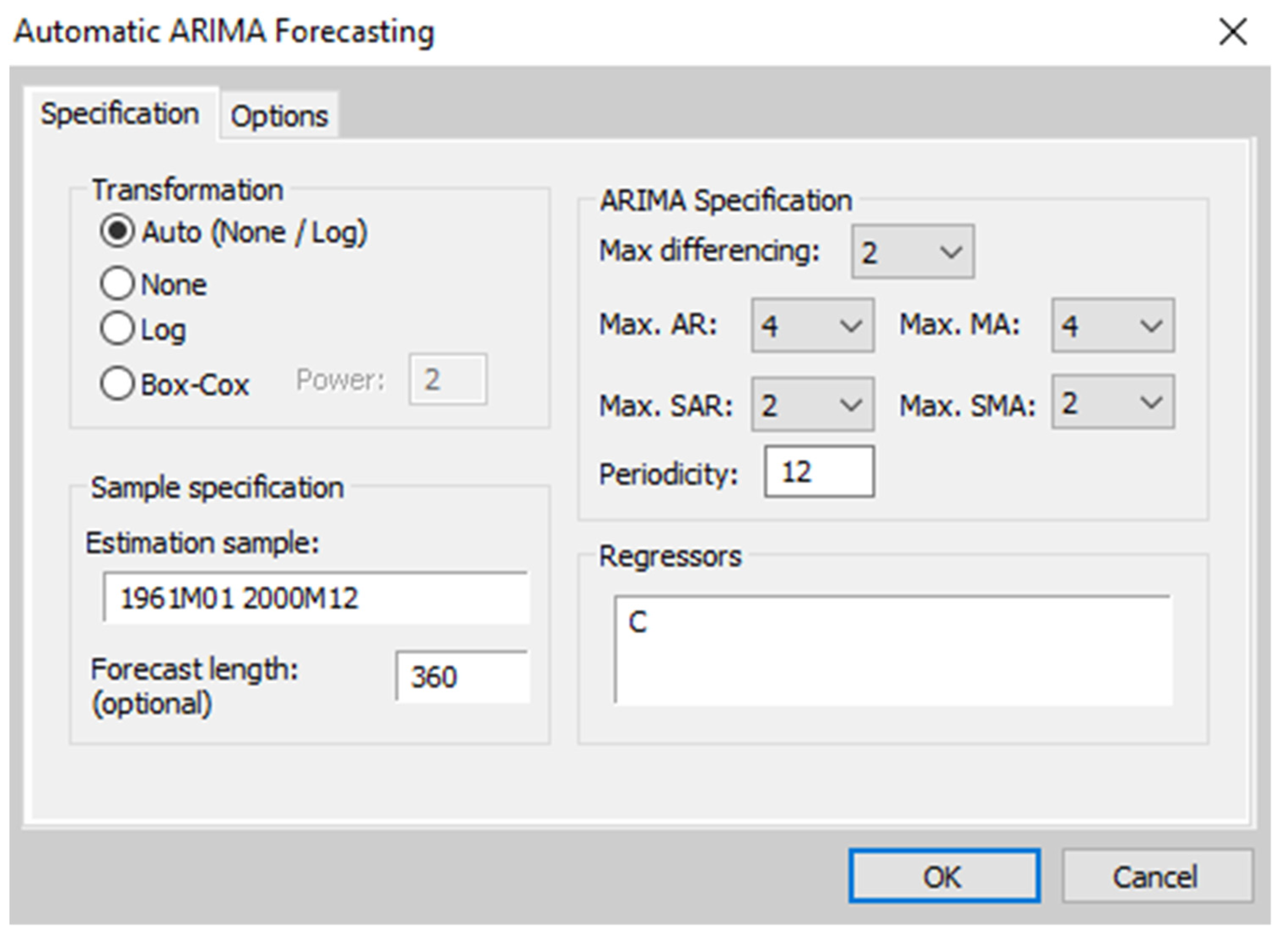
Appendix C
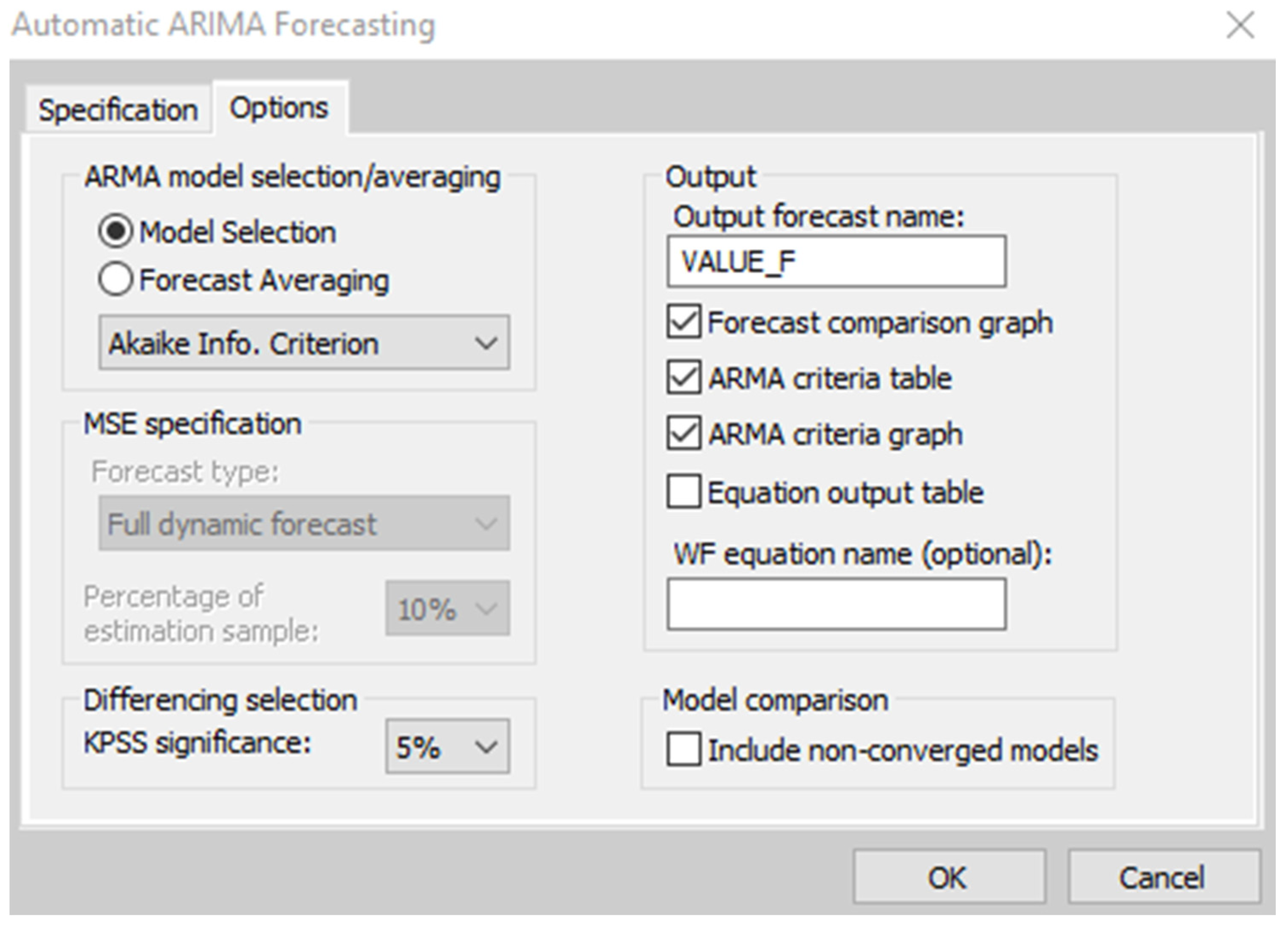
References
- Haidvogl, G. Historic milestones of human river uses and ecological impacts. In Riverine Ecosystem Management; Huisman, J., Ed.; Springer: Berlin/Heidelberg, Germany, 2018; pp. 19–39. [Google Scholar]
- Aslam, B.; Maqsoom, A.; Alaloul, W.S.; Musarat, M.A.; Jabbar, T.; Zafar, A. Soil erosion susceptibility mapping using a GIS-based multi-criteria decision approach: Case of district Chitral, Pakistan. Ain Shams Eng. J. 2021, 12, 1637–1649. [Google Scholar] [CrossRef]
- Ahmed, I.; Debnath, J.; Das, N. Impact of river on human life: A case study on the Gumti River, Tripura. Radix International. J. Res. Soc. Sci. 2015, 4, 1–13. [Google Scholar]
- Zhang, Y.; Xia, J.; Liang, T.; Shao, Q. Impact of Water Projects on River Flow Regimes and Water Quality in Huai River Basin. Water Resour. Manag. 2009, 24, 889–908. [Google Scholar] [CrossRef]
- Nguyen, X.H. Combining statistical machine learning models with ARIMA for water level forecasting: The case of the Red river. Adv. Water Resour. 2020, 142, 103656. [Google Scholar]
- Sapitang, M.; Ridwan, W.M.; Kushiar, K.F.; Ahmed, A.N.; El-Shafie, A. Machine Learning Application in Reservoir Water Level Forecasting for Sustainable Hydropower Generation Strategy. Sustainability 2020, 12, 6121. [Google Scholar] [CrossRef]
- Khatibi, R.; Sivakumar, B.; Ghorbani, M.A.; Kisi, O.; Koçak, K.; Zadeh, D.F. Investigating chaos in river stage and discharge time series. J. Hydrol. 2012, 414, 108–117. [Google Scholar] [CrossRef]
- Mack, T.J.; Chornack, M.P.; Taher, M.R. Groundwater-level trends and implications for sustainable water use in the Kabul Basin, Afghanistan. Environ. Syst. Decis. 2013, 33, 457–467. [Google Scholar] [CrossRef]
- Iqbal, M.S.; Hofstra, N. Modeling Escherichia coli fate and transport in the Kabul River Basin using SWAT. Hum. Ecol. Risk Assess. Int. J. 2018, 25, 1279–1297. [Google Scholar] [CrossRef]
- Mehmood, A.; Jia, S.; Lv, A.; Zhu, W.; Mahmood, R.; Saifullah, M.; Adnan, R. Detection of Spatial Shift in Flood Regime of the Kabul River Basin in Pakistan, Causes, Challenges, and Opportunities. Water 2021, 13, 1276. [Google Scholar] [CrossRef]
- Khan, H.F.; Yang, Y.C.E.; Wi, S. Case Study on Hydropolitics in Afghanistan and Pakistan: Energy and Water Impacts of Kunar River Development. J. Water Resour. Plan. Manag. 2020, 146, 05020015. [Google Scholar] [CrossRef]
- Qureshi, W.A. Water as a human right: A case study of the Pakistan-India water conflict. Penn St. JL Int’l Aff. 2017, 5, 374. [Google Scholar]
- Tariq, M.A.; van de Giesen, N.; Janjua, S.; Shahid, M.L.; Farooq, R. An engineering perspective of water sharing issues in Pakistan. Water. 2020, 12, 477. [Google Scholar] [CrossRef]
- Ghulami, M.; Gourbesville, P.; Audra, P. Assessing Future Water Availability Under a Changing Climate in Kabul Basin. Adv. Hydroinform. 2020, 1, 647–657. [Google Scholar]
- Haider, R. Climate Change Projections of Kabul River Basin using Multi-Model Ensemble. Leadersh. Environ. Dev. Pak. 2018, 2, 1–4. [Google Scholar]
- Chaudhry, Q.U.Z. Climate Change Profile of Pakistan; Asian Development Bank: Mandaluyong, Philippines, 2017; pp. 1–130. [Google Scholar]
- Sayama, T.; Ozawa, G.; Kawakami, T.; Nabesaka, S.; Fukami, K. Rainfall–runoff–inundation analysis of the 2010 Pakistan flood in the Kabul River basin. Hydrol. Sci. J. 2012, 57, 298–312. [Google Scholar] [CrossRef]
- Hanasz, P. The politics of water security in the Kabul river basin. Atl. Mon. 2011, 10, 1–7. [Google Scholar]
- Rasul, G.; Chaudhry, Q.Z.; Mahmood, A.; Hyder, K.W.; Dahe, Q. Glaciers and glacial lakes under changing climate in Pakistan. Pak. J. Meteorol. 2011, 8, 1–8. [Google Scholar]
- Nafees, M. Role of Kabul River in Socio-economic Activities and Associated Environmental Problems. Cent. Asia 2010, 67, 83–97. [Google Scholar]
- Nafees, M.; Shabir, A.; Zahid, U. Construction of dam on Kabul River and its socio-economic implication for Khyber Pukhtunkhwa, Pakistan. Semin. Pak.–Afghan Water Shar. Issue 2016, 23, 2016. [Google Scholar]
- Pakistan. Government of Warsak Hydroelectric Power Station 2nd Rehabilitation Project. 2015. Available online: https://mowr.gov.pk/index.php/warsak-hydroelectric-power-station-2nd-rehabilitation-project/ (accessed on 12 April 2021).
- Iqbal, M.S.; Dahri, Z.H.; Querner, E.P.; Khan, A.; Hofstra, N. Impact of Climate Change on Flood Frequency and Intensity in the Kabul River Basin. Geoscience 2018, 8, 114. [Google Scholar] [CrossRef]
- Hasson, S.U.; Saeed, F.; Böhner, J.; Schleussner, C.-F. Water availability in Pakistan from Hindukush–Karakoram–Himalayan watersheds at 1.5 °C and 2 °C Paris Agreement targets. Adv. Water Resour. 2019, 131, 103365. [Google Scholar] [CrossRef]
- Britannica, T.E.O.E. Pakistan Floods of 2010; Tesch, N., Ed.; Encyclopedia Britannica Press; Britannica, UK, 2020. [Google Scholar]
- O’Neill, A. Pakistan: Distribution of Employment by Economic Sector from 2010 to 2020. Available online: statista.com (accessed on 11 April 2021).
- Taraky, Y.; Liu, Y.; McBean, E.; Daggupati, P.; Gharabaghi, B. Flood Risk Management with Transboundary Conflict and Cooperation Dynamics in the Kabul River Basin. Water 2021, 13, 1513. [Google Scholar] [CrossRef]
- Khattak, M.S.; Anwar, F.; Saeed, T.U.; Sharif, M.; Sheraz, K.; Ahmed, A. Floodplain Mapping Using HEC-RAS and ArcGIS: A Case Study of Kabul River. Arab. J. Sci. Eng. 2015, 41, 1375–1390. [Google Scholar] [CrossRef]
- Terzi, Ö.; Ergin, G. Forecasting of monthly river flow with autoregressive modeling and data-driven techniques. Neural Comput. Appl. 2014, 25, 179–188. [Google Scholar] [CrossRef]
- Yaseen, Z.M.; El-Shafie, A.; Jaafar, O.; Afan, H.A.; Sayl, K.N. Artificial intelligence based models for stream-flow forecasting: 2000–2015. J. Hydrol. 2015, 530, 829–844. [Google Scholar] [CrossRef]
- Mohammed, M.; Khan, M.B.; Bashier, E.B.M. Machine Learning: Algorithms and Applications; CRC Press: Boca Raton, FL, USA, 2016. [Google Scholar]
- Mullainathan, S.; Spiess, J. Machine Learning: An Applied Econometric Approach. J. Econ. Perspect. 2017, 31, 87–106. [Google Scholar] [CrossRef]
- Zakaria, M.N.A.; Malek, M.A.; Zolkepli, M.; Ahmed, A.N. Application of artificial intelligence algorithms for hourly river level forecast: A case study of Muda River, Malaysia. Alex. Eng. J. 2021, 60, 4015–4028. [Google Scholar] [CrossRef]
- Piri, J.; Kahkha, M.R.R. Prediction of water level fluctuations of Chahnimeh reservoirs in Zabol using ANN, ANFIS and cuckoo optimization algorithm. Iran. J. Health Saf. Environ. 2017, 4, 706–715. [Google Scholar]
- Üneş, F.; Demirci, M.; Tasar, B.; Kaya, Y.Z.; Varcin, H. Estimating dam reservoir level fluctuations using data-driven techniques. Pol. J. Environ. Stud. 2019, 28, 3451–3462. [Google Scholar] [CrossRef]
- Seo, Y.; Kim, S.; Singh, V.P. Multistep-ahead flood forecasting using wavelet and data-driven methods. KSCE J. Civ. Eng. 2015, 19, 401–417. [Google Scholar] [CrossRef]
- Seo, Y.; Kim, S.; Kisi, O.; Singh, V.P. Daily water level forecasting using wavelet decomposition and artificial intelligence techniques. J. Hydrol. 2015, 520, 224–243. [Google Scholar] [CrossRef]
- Guo, T.; He, W.; Jiang, Z.; Chu, X.; Malekian, R.; Li, Z. An Improved LSSVM Model for Intelligent Prediction of the Daily Water Level. Energies 2018, 12, 112. [Google Scholar] [CrossRef]
- Jamil, R. Hydroelectricity consumption forecast for Pakistan using ARIMA modeling and supply-demand analysis for the year 2030. Renew. Energy 2020, 154, 1–10. [Google Scholar] [CrossRef]
- Dickey, D.A.; Fuller, W.A. Distribution of the estimators for autoregressive time series with a unit root. J. Am. Stat. Assoc. 1979, 74, 427–431. [Google Scholar]
- Fuller, W.A. Introduction to Statistical Time Series; John Wiley & Sons: Hoboken, NJ, USA, 1976. [Google Scholar]
- Masani, R. Norbert Wiener 1894–1964; Birkhäuser: Basel, Switzerland, 2012; Volume 5. [Google Scholar]
- Box, G. Time Series Analysis: Forecasting and Control by George EP Box and Gwilym M; Holden-Day: San Francisco, CA, USA, 1970. [Google Scholar]
- Shahwan, T.; Odening, M. Forecasting agricultural commodity prices using hybrid neural networks. In Computational Intelligence in Economics and Finance; Springer: Berlin/Heidelberg, Germany, 2007; pp. 63–74. [Google Scholar]
- Whittle. Hypothesis Testing in Time Series Analysis; Almqvist & Wiksells boktr: Stockholm, Sweden, 1951; Volume 4. [Google Scholar]
- Hyndman, R.J.; Athanasopoulos, G. Forecasting: Principles and Practice, 2nd ed.; OTexts: Melbourne, Australia, 2018; Volume 1, pp. 1–384. [Google Scholar]
- Akaike, H. Information Theory and an Extension of the Maximum Likelihood Principle, in Selected Papers of Hirotugu Akaike; Springer: Berlin/Heidelberg, Germany, 1998; pp. 199–213. [Google Scholar]
- Hirotugu Akaike. Factor Analysis and AIC; Selected papers of Hirotugu Akaike; Springer: New York, NY, USA, 1987; pp. 371–386. [Google Scholar]
- Taddy, M. Business data science: Combining machine learning and economics to optimize, automate, and accelerate business decisions. McGraw Hill Prof. 2019, 1, 1–359. [Google Scholar]
- Akaike, H. A new look at the statistical model identification. IEEE Trans. Autom. Control 1974, 19, 716–723. [Google Scholar] [CrossRef]
- Schwarz, G. The annals of statistics. Estim. Dimens. A Model 1978, 6, 461–464. [Google Scholar]
- Burnham, K.P.; Anderson, D.R. A practical information-theoretic approach. Model Sel. Multimodel Inference 2002, 2, 267–344. [Google Scholar]
- Wit, E.; Heuvel, E.V.D.; Romeijn, J.W. ‘All models are wrong...’: An introduction to model uncertainty. Stat. Neerl. 2012, 66, 217–236. [Google Scholar] [CrossRef]
- Vrieze, S.I. Model selection and psychological theory: A discussion of the differences between the Akaike information criterion (AIC) and the Bayesian information criterion (BIC). Psychol. Methods 2012, 17, 228. [Google Scholar] [CrossRef]
- Burnham, K.P.; Anderson, D.R. Multimodel inference: Understanding AIC and BIC in model selection. Sociol. Methods Res. 2004, 33, 261–304. [Google Scholar] [CrossRef]
- Aho, K.; Derryberry, D.; Peterson, T. Model selection for ecologists: The worldviews of AIC and BIC. Ecology 2014, 95, 631–636. [Google Scholar] [CrossRef] [PubMed]
- Barnston, A.G. Correspondence among the correlation, RMSE, and Heidke forecast verification measures; refinement of the Heidke score. Weather. Forecast. 1992, 7, 699–709. [Google Scholar] [CrossRef]
- Kenney, J.F. Mathematics of Statistics; D. Van Nostrand: New York, NY, USA, 1939. [Google Scholar]
- Everitt, B.; Skrondal, A. The Cambridge Dictionary of Statistics; Cambridge University Press: Cambridge, UK, 2002; Volume 106. [Google Scholar]
- Read, C.B.; Vidakovic, B. Encyclopedia of Statistical Sciences; John Wiley & Sons: Hoboken, NJ, USA, 2006; Volume 2. [Google Scholar]
- Willmott, C.; Matsuura, K. Advantages of the mean absolute error (MAE) over the root mean square error (RMSE) in assessing average model performance. Clim. Res. 2005, 30, 79–82. [Google Scholar] [CrossRef]
- Dodge, Y. The Concise Encyclopedia of Statistics; Springer Science & Business Media: Berlin/Heidelberg, Germany, 2008. [Google Scholar]
- Khair, U.; Fahmi, H.; Al Hakim, S.; Rahim, R. Forecasting error calculation with mean absolute deviation and mean absolute percentage error. J. Phys. 2017, 930, 012002. [Google Scholar] [CrossRef]
- Agung, I.G.N. Time Series Data Analysis Using EViews; John Wiley & Sons: Hoboken, NJ, USA, 2011. [Google Scholar]
- Katimon, A.; Shahid, S.; Mohsenipour, M. Modeling water quality and hydrological variables using ARIMA: A case study of Johor River, Malaysia. Sustain. Water Resour. Manag. 2017, 4, 991–998. [Google Scholar] [CrossRef]
- Birylo, M.; Rzepecka, Z.; Kuczynska-Siehien, J.; Nastula, J. Analysis of water budget prediction accuracy using ARIMA models. Water Supply 2017, 18, 819–830. [Google Scholar] [CrossRef]
- Valipour, M.; Banihabib, M.E.; Behbahani, S.M.R. Comparison of the ARMA, ARIMA, and the autoregressive artificial neural network models in forecasting the monthly inflow of Dez dam reservoir. J. Hydrol. 2012, 476, 433–441. [Google Scholar] [CrossRef]
- Woodward, W.A.; Gray, H.L.; Elliott, A.C. Applied Time Series Analysis with R; CRC Press: Boca Raton, FL, USA, 2017. [Google Scholar]
- Yu, Z.; Lei, G.; Jiang, Z.; Liu, F. ARIMA modelling and forecasting of water level in the middle reach of the Yangtze River in 2017. In Proceedings of the 4th International Conference on Transportation Information and Safety (ICTIS), Banff, AB, Canada, 8–10 August 2017. [Google Scholar]
- Gao, Y.; Merz, C.; Lischeid, G.; Schneider, M. A review on missing hydrological data processing. Environ. Earth Sci. 2018, 77, 47. [Google Scholar] [CrossRef]
- Gao, Y. Dealing with missing data in hydrology: Data Analysis of Discharge and Groundwater Time-Series in Northeast Germany. Ph.D. Thesis, Freie Universität Berlin, Berlin, Germany, 2017. [Google Scholar]
- Gibrilla, A.; Anornu, G.; Adomako, D. Trend analysis and ARIMA modelling of recent groundwater levels in the White Volta River basin of Ghana. Groundw. Sustain. Dev. 2018, 6, 150–163. [Google Scholar] [CrossRef]
- Valipour, M. Long-term runoff study using SARIMA and ARIMA models in the United States. Meteorol. Appl. 2015, 22, 592–598. [Google Scholar] [CrossRef]
- Nigam, R.; Nigam, S.; Mittal, S.K. The river runoff forecast based on the modeling of time series. Russ. Meteorol. Hydrol. 2014, 39, 750–761. [Google Scholar] [CrossRef]
- Ghimire, B.N. Application of ARIMA Model for River Discharges Analysis. J. Nepal Phys. Soc. 2017, 4, 27–32. [Google Scholar] [CrossRef]
- Bin Shaari, M.A.; Samsudin, R.; Bin Shabri Ilman, A. Comparison of drought forecasting using ARIMA and empirical wavelet Transform-ARIMA. In Proceedings of the International Conference of Reliable Information and Communication Technology, Johor, Malaysia, 23–24 April 2017. [Google Scholar]
- Bazrafshan, O.; Salajegheh, A.; Bazrafshan, J.; Mahdavi, M.; Maraj, A.F. Hydrological drought forecasting using ARIMA models (case study: Karkheh Basin). Ecopersia 2015, 3, 1099–1117. [Google Scholar]
- Gharde, K.; Kothari, M.; Mahale, D. Developed seasonal ARIMA model to forecast streamflow for Savitri Basin in Konkan Region of Maharshtra on daily basis. J. Indian Soc. Coast. Agric. Res. 2016, 34, 110–119. [Google Scholar]
- Myronidis, D.; Ioannou, K.; Fotakis, D.; Dörflinger, G. Streamflow and Hydrological Drought Trend Analysis and Forecasting in Cyprus. Water Resour. Manag. 2018, 32, 1759–1776. [Google Scholar] [CrossRef]
- Rahaman, M.; Thakur, B.; Kalra, A.; Ahmad, S. Modeling of GRACE-Derived Groundwater Information in the Colorado River Basin. Hydrology 2019, 6, 19. [Google Scholar] [CrossRef]
- Guide, E.U. Automatic ARIMA Forecasting. 2020. Available online: http://www.eviews.com/help/helpintro.html#page/content%2Fseries-Automatic_ARIMA_Forecasting.html%23ww154388 (accessed on 20 April 2021).
- Azam, S. Kabul River Treaty: A Necessity for Peace-n-Security between Afghanistan and Pakistan, and Peace in South Asia. Gomal Univ. J. Res. 2015, 31, 134–145. [Google Scholar]
- Malik, T. Pak-Afghan Water Issue: A Case for Benefit-Sharing. Policy Perspect. 2019, 16, 77–98. [Google Scholar] [CrossRef]
- Masood, A.; Hashmi, M.Z.U.R.; Mushtaq, H. Spatio-Temporal Analysis of Early Twenty-First Century Areal Changes in the Kabul River Basin Cryosphere. Earth Syst. Environ. 2018, 2, 563–571. [Google Scholar] [CrossRef]
- Sultan, M.; Assadullah, A. New hydrological station at Qargha Dam to help manage Afghanistan’s water resources. Food Agric. Organ. 2008. Available online: https://reliefweb.int/report/afghanistan/new-hydrological-station-qargha-dam-help-manage-afghanistans-water-resources (accessed on 18 April 2021).
- Akhtar, S.M.; Iqbal, J. Assessment of emerging hydrological, water quality issues and policy discussion on water sharing of transboundary Kabul River. Hydrol. Res. 2017, 19, 650–672. [Google Scholar] [CrossRef][Green Version]
- Atef, S.S.; Sadeqinazhad, F.; Farjaad, F.; Amatya, D.M. Water conflict management and cooperation between Afghanistan and Pakistan. J. Hydrol. 2019, 570, 875–892. [Google Scholar] [CrossRef]
- Khan, S.; Pervaz, I. The Brewing Conflict over Kabul River; Policy Options for Legal Framework. ISSRA Pap. 2014, 1, 17–38. [Google Scholar]
- Dong, X.; Dhmen-Janssen, C.M.; Booij, M.J.; Hulscher, S.J.M.H. Requirements and benefits of flow forecasting for improving hydropower generation. In Stochastic Hydraulics; IAHR: Madrid, Spain, 2005; pp. 60–63. [Google Scholar]
- Krajewski, W.F.; Ceynar, D.; Demir, I.; Goska, R.; Kruger, A.; Langel, C.; Mantilla, R.; Niemeier, J.; Quintero, F.; Seo, B.-C.; et al. Real-Time Flood Forecasting and Information System for the State of Iowa. Bull. Am. Meteorol. Soc. 2017, 98, 539–554. [Google Scholar] [CrossRef]
- Pianosi, F.; Thi, X.Q.; Soncini-Sessa, R. Artificial Neural Networks and Multi Objective Genetic Algorithms for water resources management: An application to the Hoabinh reservoir in Vietnam. IFAC Proc. Vol. 2011, 44, 10579–10584. [Google Scholar] [CrossRef]
- Wu, J.S.; Han, J.; Annambhotla, S.; Bryant, S. Artificial Neural Networks for Forecasting Watershed Runoff and Stream Flows. J. Hydrol. Eng. 2005, 10, 216–222. [Google Scholar] [CrossRef]
- Hashmi, H.N.; Siddiqui, Q.T.M.; Ghumman, A.R.; Kamal, M.A. A critical analysis of 2010 floods in Pakistan. Afr. J. Agric. Res. 2012, 7, 1054–1067. [Google Scholar]
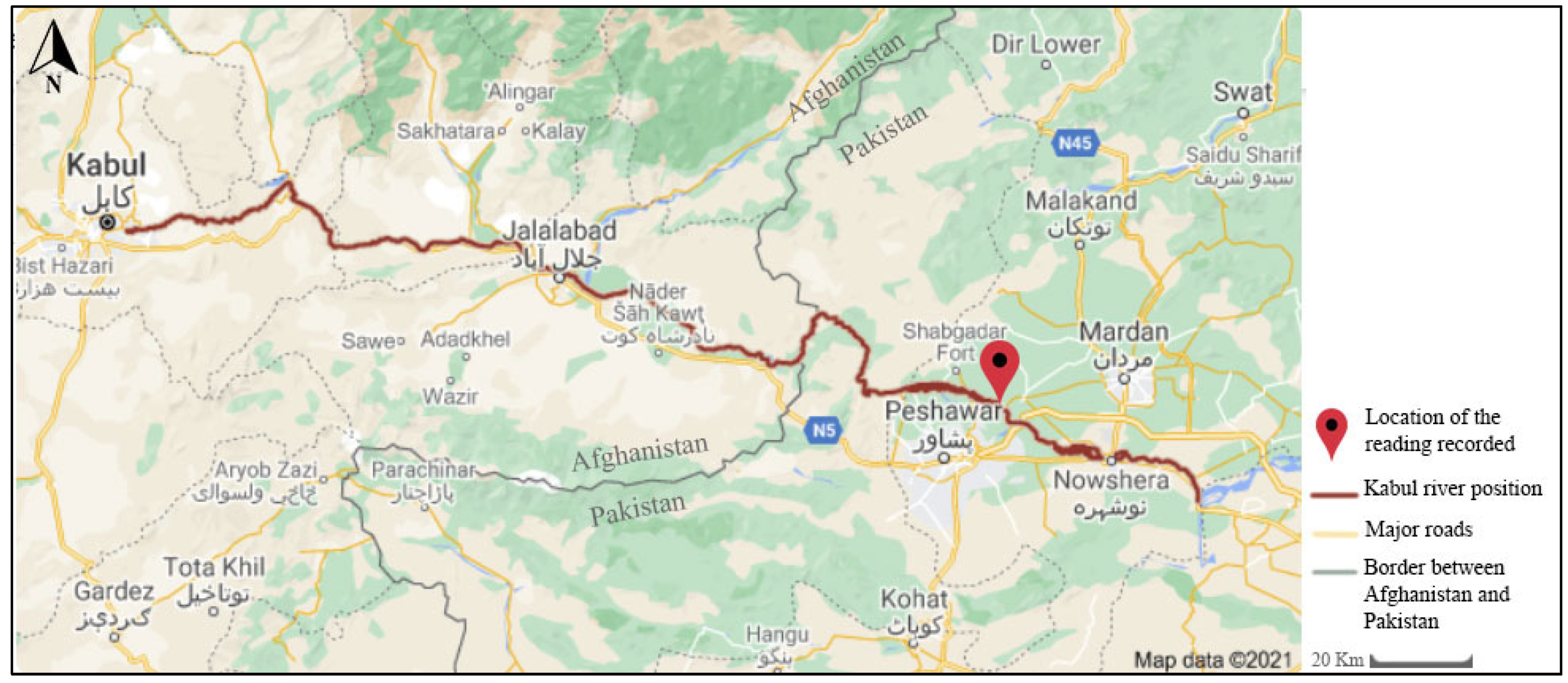
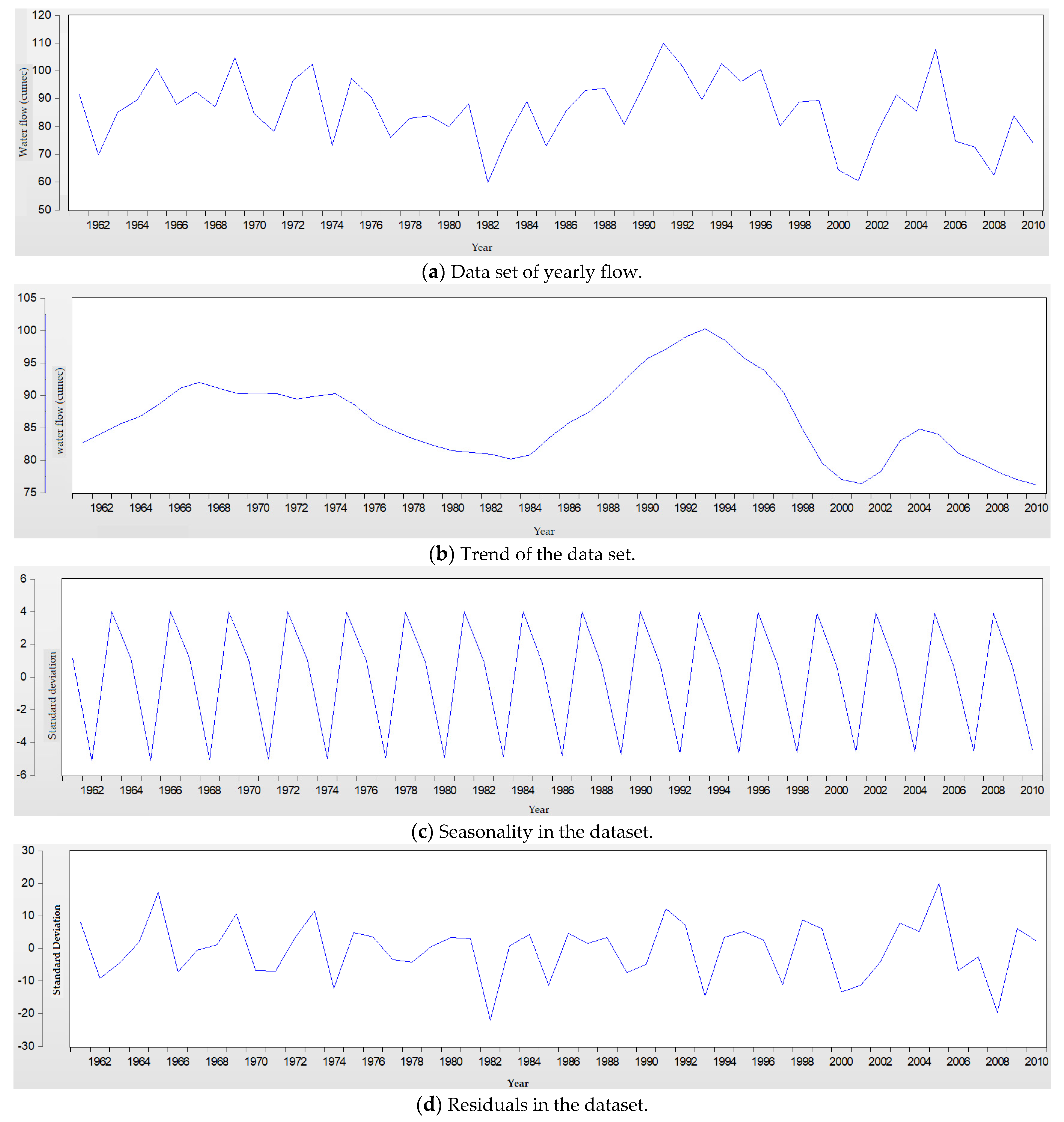
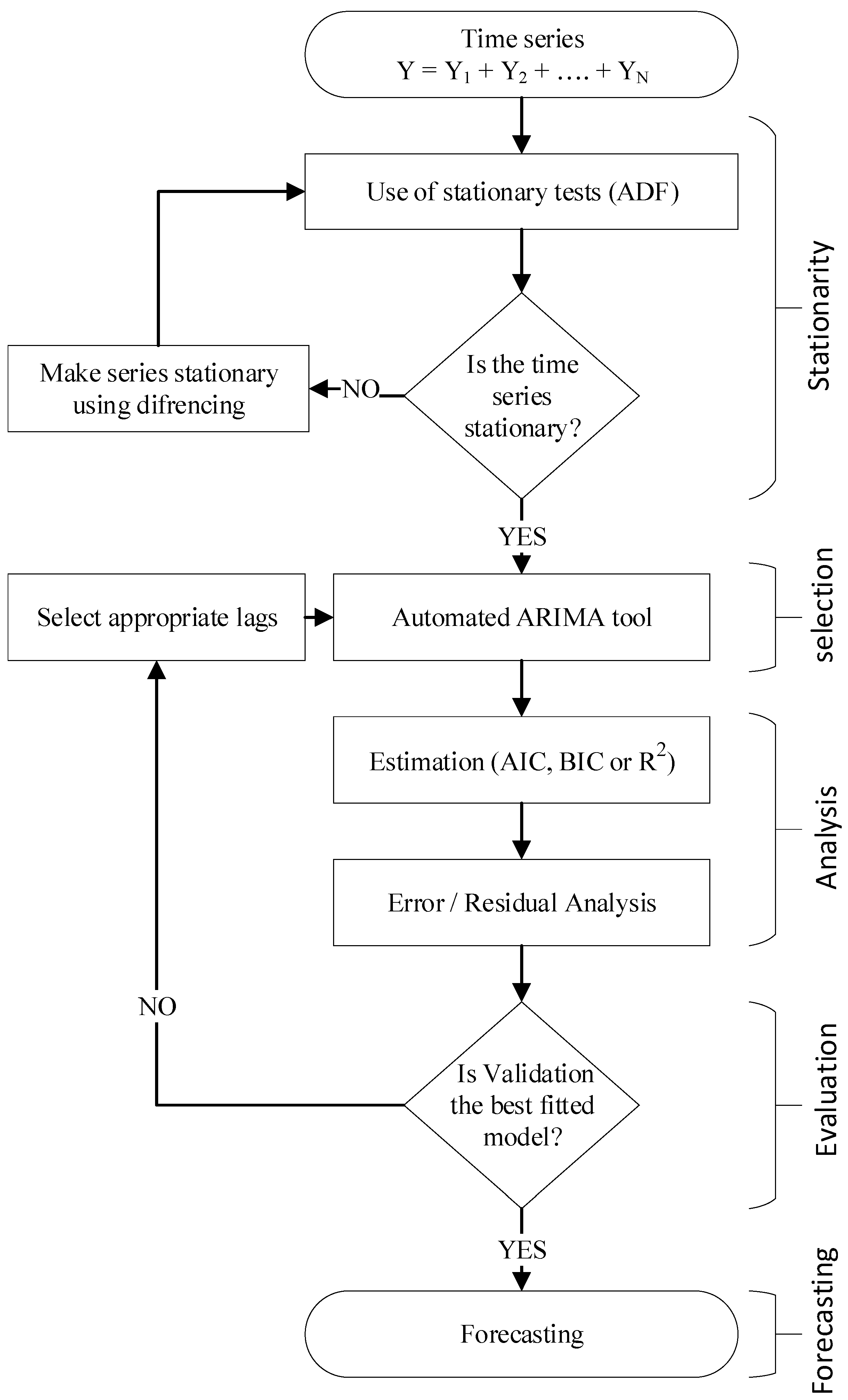
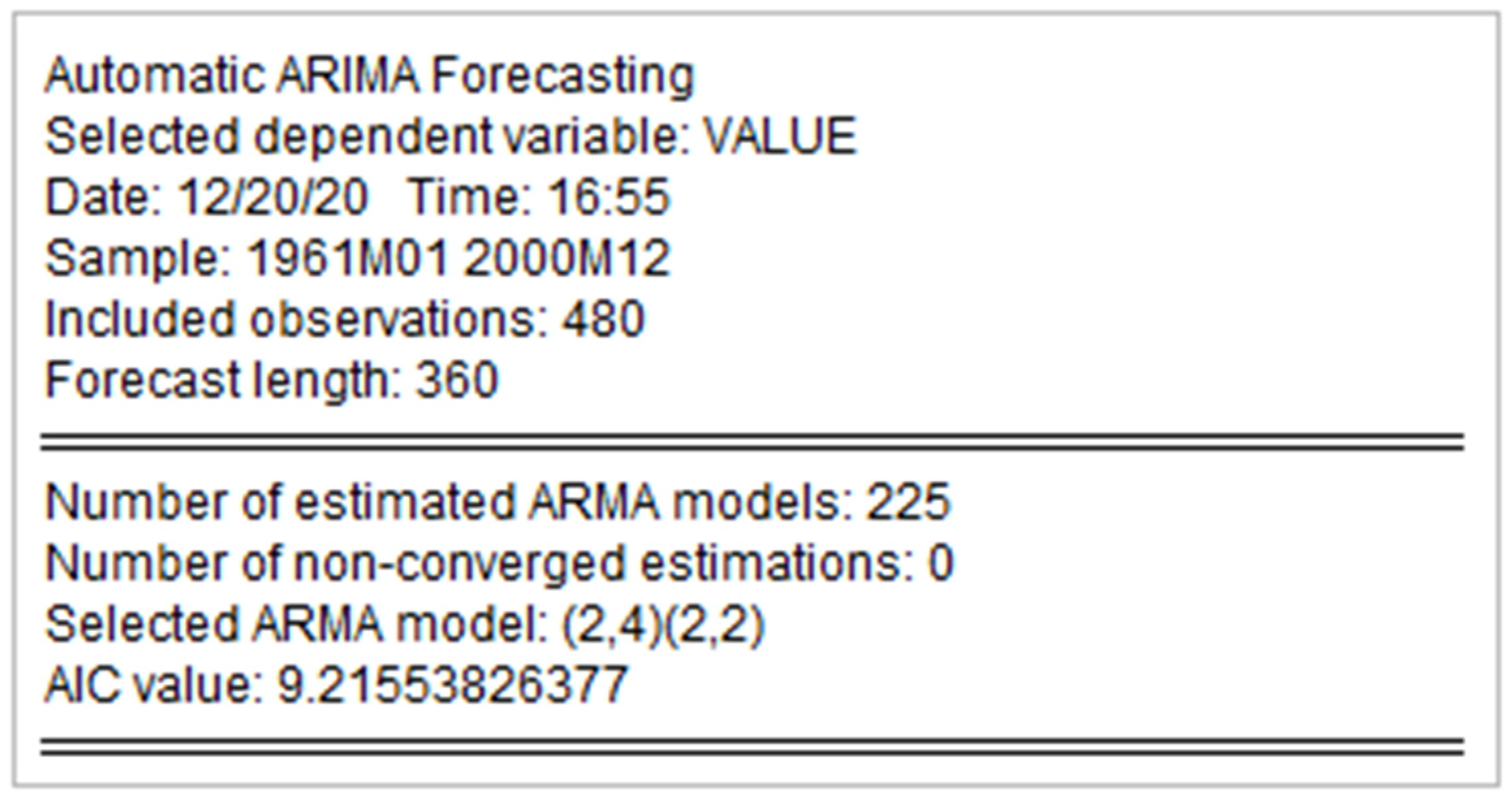
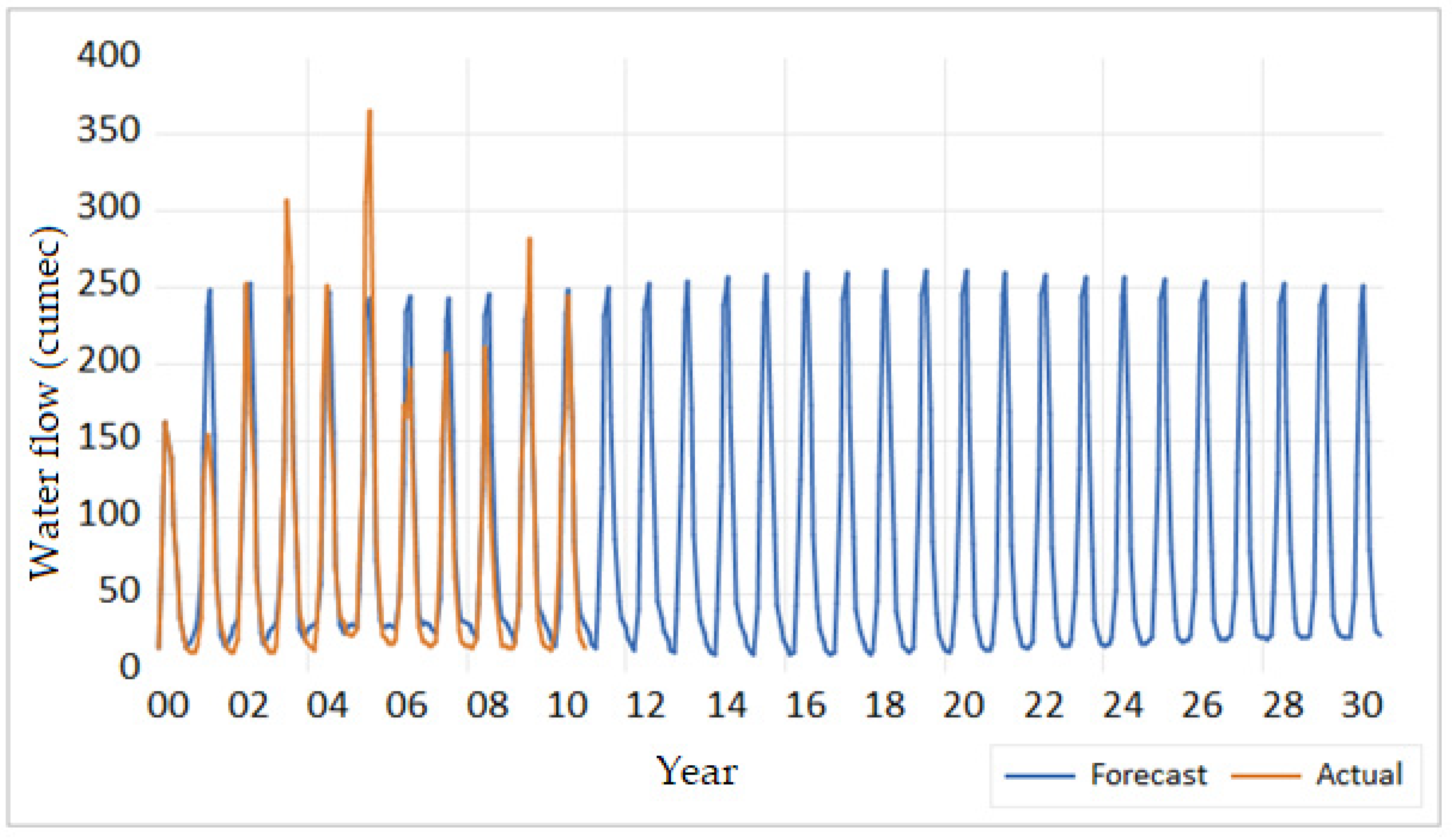
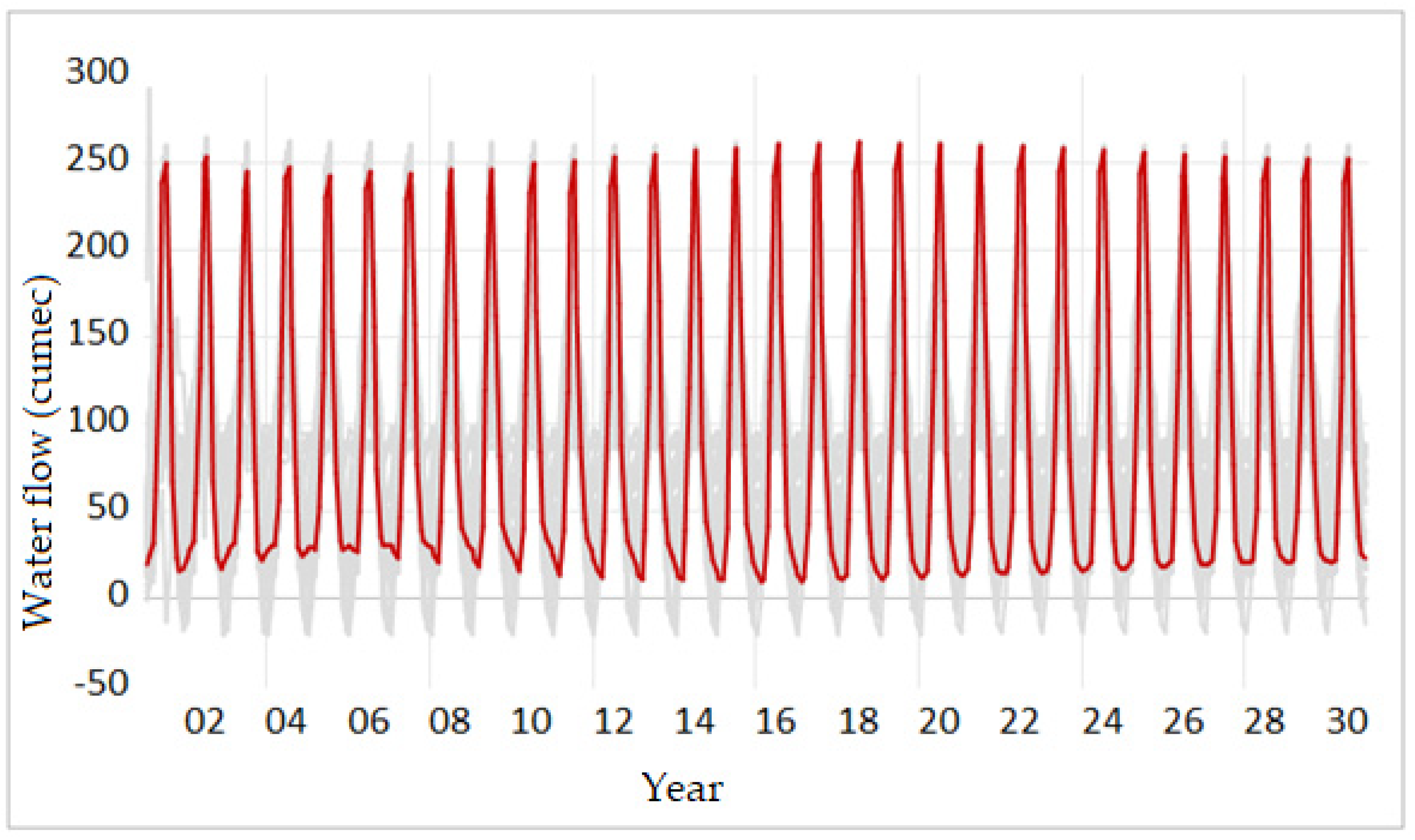
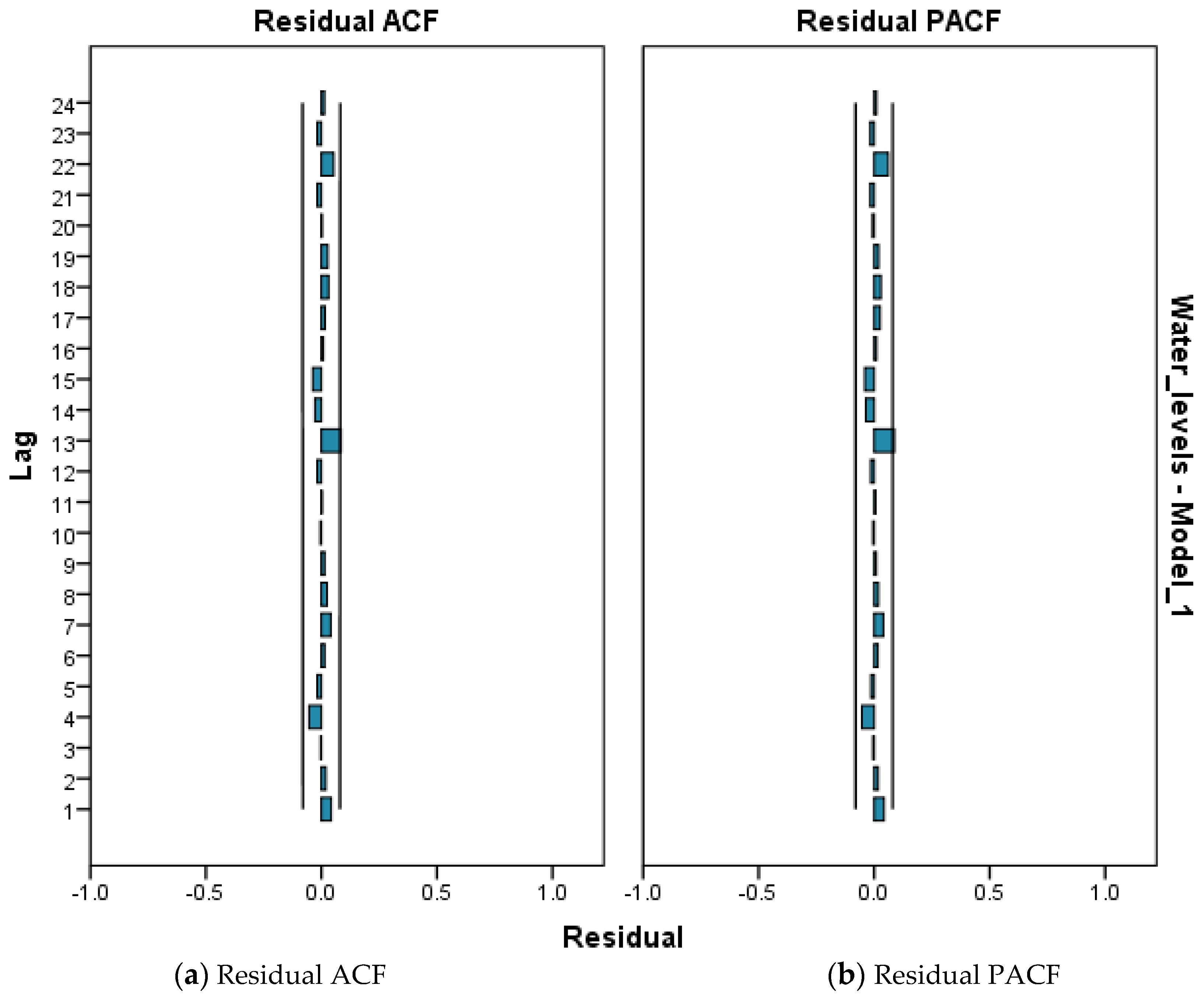
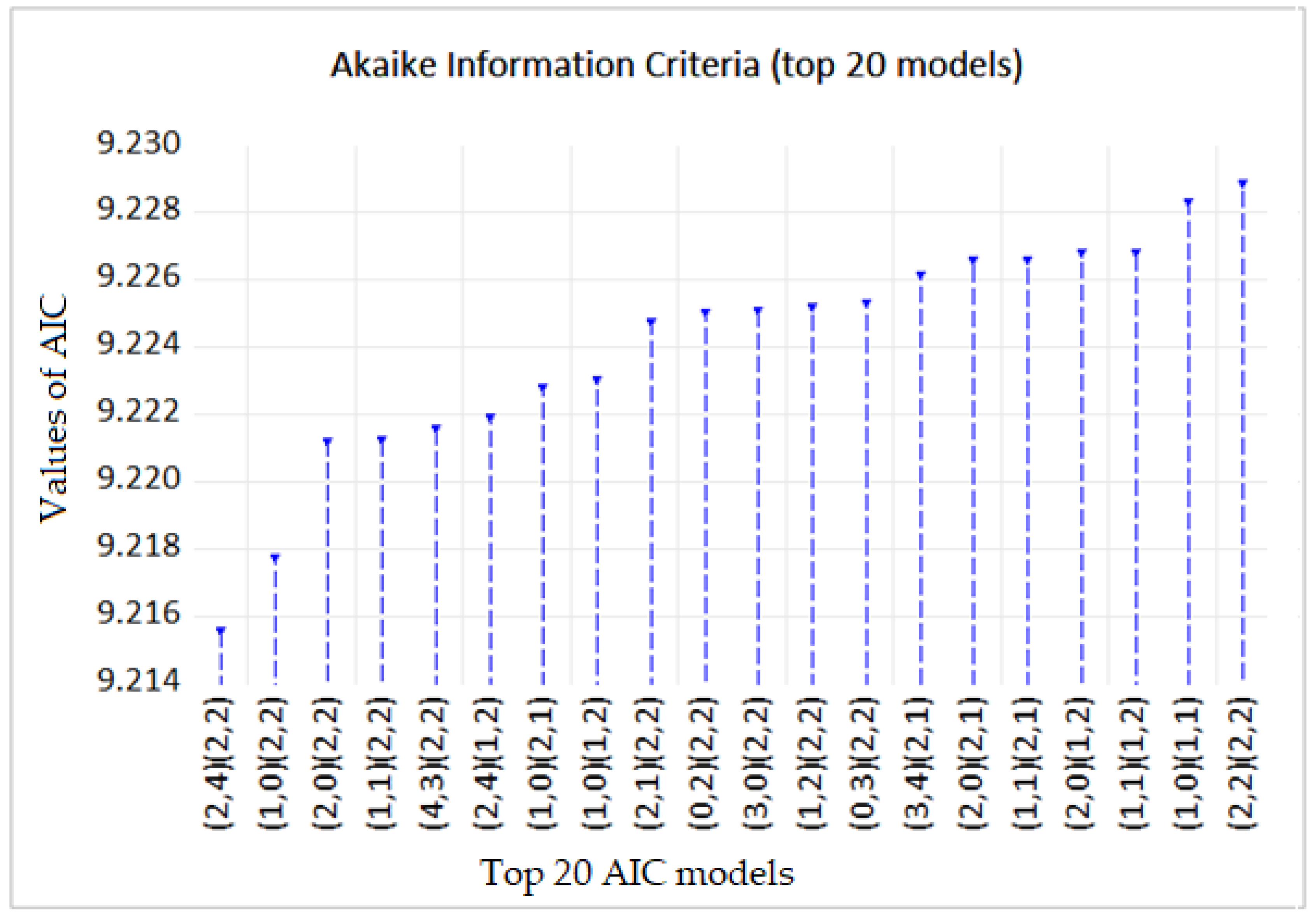
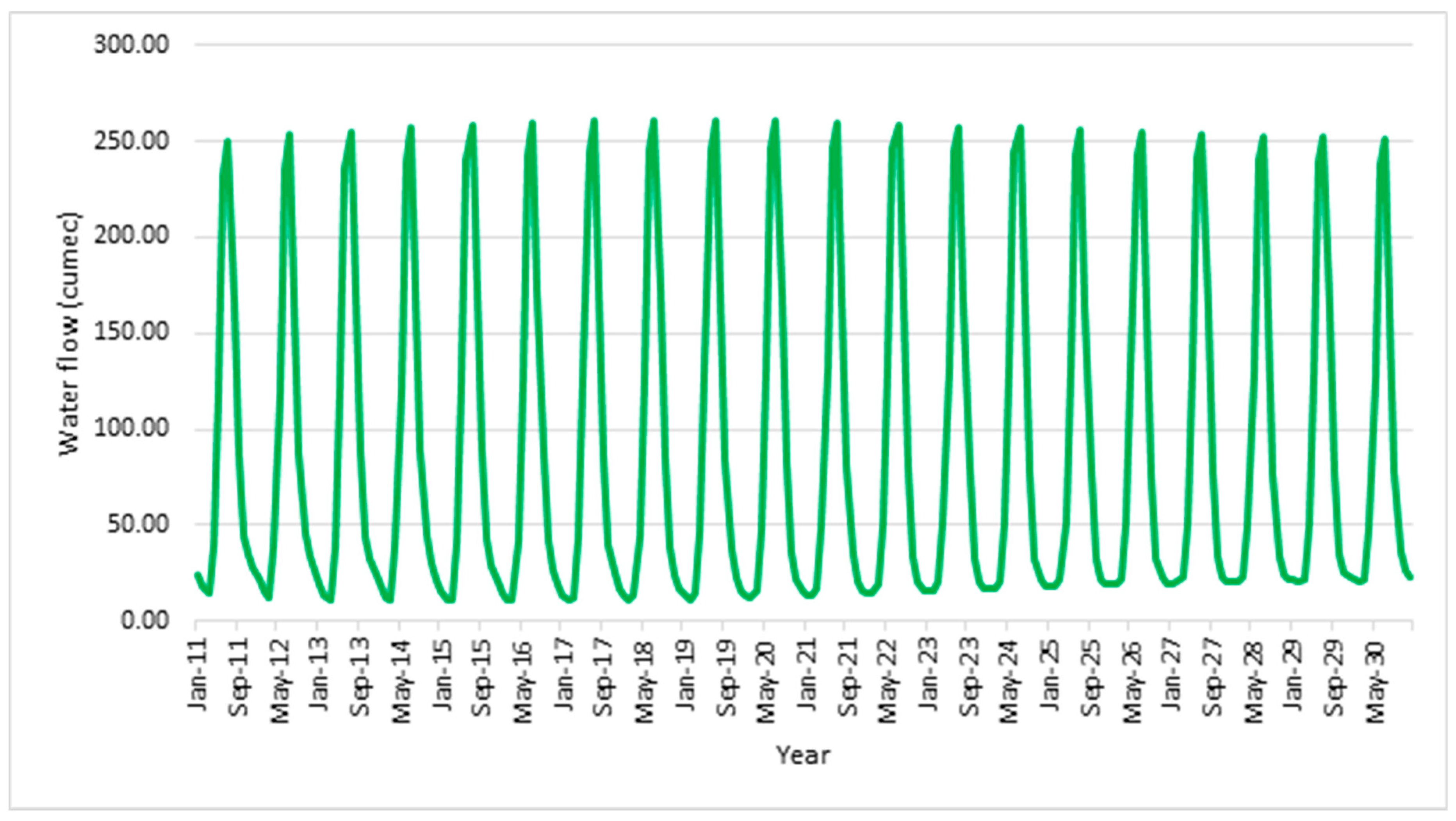
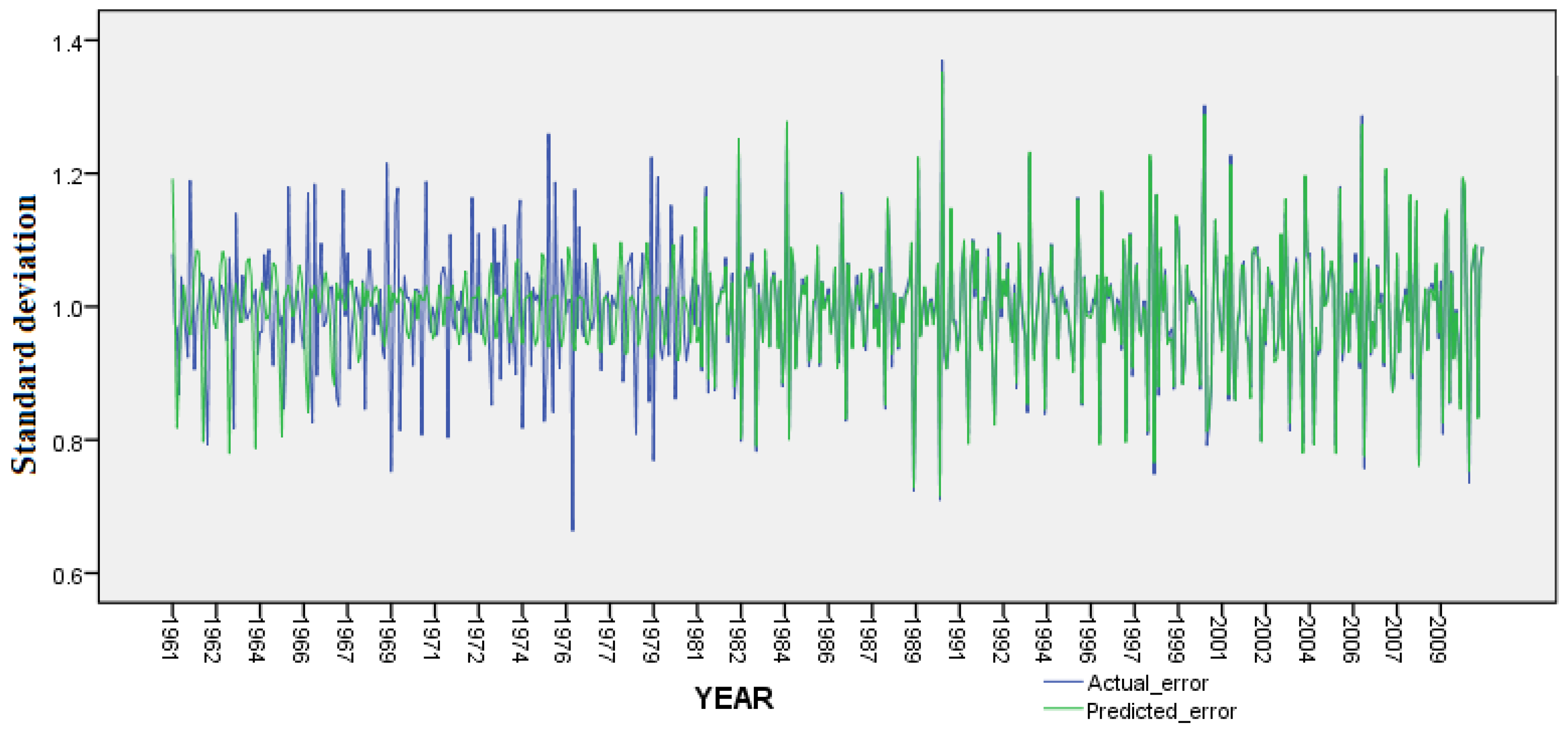
| Model | Model Fit Statistics | |||
|---|---|---|---|---|
| R-Squared | RMSE | MAPE | MAE | |
| Water_level_1 | 0.922 | 25.253 | 20.110 | 14.188 |
Publisher’s Note: MDPI stays neutral with regard to jurisdictional claims in published maps and institutional affiliations. |
© 2021 by the authors. Licensee MDPI, Basel, Switzerland. This article is an open access article distributed under the terms and conditions of the Creative Commons Attribution (CC BY) license (https://creativecommons.org/licenses/by/4.0/).
Share and Cite
Musarat, M.A.; Alaloul, W.S.; Rabbani, M.B.A.; Ali, M.; Altaf, M.; Fediuk, R.; Vatin, N.; Klyuev, S.; Bukhari, H.; Sadiq, A.; et al. Kabul River Flow Prediction Using Automated ARIMA Forecasting: A Machine Learning Approach. Sustainability 2021, 13, 10720. https://doi.org/10.3390/su131910720
Musarat MA, Alaloul WS, Rabbani MBA, Ali M, Altaf M, Fediuk R, Vatin N, Klyuev S, Bukhari H, Sadiq A, et al. Kabul River Flow Prediction Using Automated ARIMA Forecasting: A Machine Learning Approach. Sustainability. 2021; 13(19):10720. https://doi.org/10.3390/su131910720
Chicago/Turabian StyleMusarat, Muhammad Ali, Wesam Salah Alaloul, Muhammad Babar Ali Rabbani, Mujahid Ali, Muhammad Altaf, Roman Fediuk, Nikolai Vatin, Sergey Klyuev, Hamna Bukhari, Alishba Sadiq, and et al. 2021. "Kabul River Flow Prediction Using Automated ARIMA Forecasting: A Machine Learning Approach" Sustainability 13, no. 19: 10720. https://doi.org/10.3390/su131910720
APA StyleMusarat, M. A., Alaloul, W. S., Rabbani, M. B. A., Ali, M., Altaf, M., Fediuk, R., Vatin, N., Klyuev, S., Bukhari, H., Sadiq, A., Rafiq, W., & Farooq, W. (2021). Kabul River Flow Prediction Using Automated ARIMA Forecasting: A Machine Learning Approach. Sustainability, 13(19), 10720. https://doi.org/10.3390/su131910720














